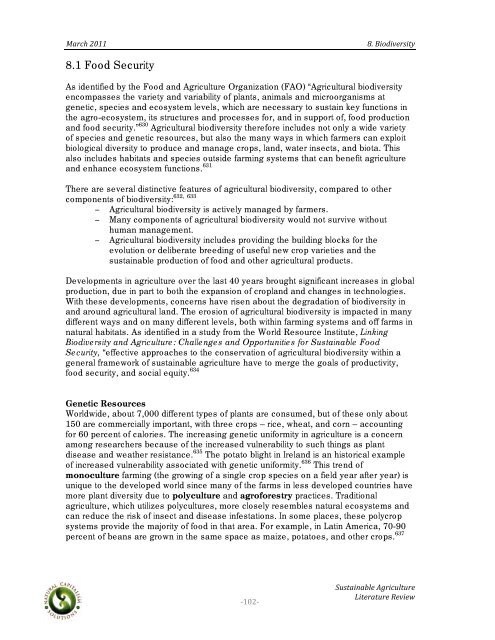Sustainable Agriculture Literature Review - Boulder County
Sustainable Agriculture Literature Review - Boulder County
Sustainable Agriculture Literature Review - Boulder County
You also want an ePaper? Increase the reach of your titles
YUMPU automatically turns print PDFs into web optimized ePapers that Google loves.
! !!<br />
"#$%&!'())!! !!!!!!!!!!!!!!!!!!!!!!!!!!!!!!!!!!!!!!!!!!!!!!!!!!!!!!!!!!!!!!!!!!!!!!!C+!D.-E.;1$4.2F!<br />
8.1 Food Security<br />
As identified by the Food and <strong>Agriculture</strong> Organization (FAO) “Agricultural biodiversity<br />
encompasses the variety and variability of plants, animals and microorganisms at<br />
genetic, species and ecosystem levels, which are necessary to sustain key functions in<br />
the agro-ecosystem, its structures and processes for, and in support of, food production<br />
and food security.” 630 Agricultural biodiversity therefore includes not only a wide variety<br />
of species and genetic resources, but also the many ways in which farmers can exploit<br />
biological diversity to produce and manage crops, land, water insects, and biota. This<br />
also includes habitats and species outside farming systems that can benefit agriculture<br />
and enhance ecosystem functions. 631<br />
There are several distinctive features of agricultural biodiversity, compared to other<br />
632, 633<br />
components of biodiversity:<br />
! Agricultural biodiversity is actively managed by farmers.<br />
! Many components of agricultural biodiversity would not survive without<br />
human management.<br />
! Agricultural biodiversity includes providing the building blocks for the<br />
evolution or deliberate breeding of useful new crop varieties and the<br />
sustainable production of food and other agricultural products.<br />
Developments in agriculture over the last 40 years brought significant increases in global<br />
production, due in part to both the expansion of cropland and changes in technologies.<br />
With these developments, concerns have risen about the degradation of biodiversity in<br />
and around agricultural land. The erosion of agricultural biodiversity is impacted in many<br />
different ways and on many different levels, both within farming systems and off farms in<br />
natural habitats. As identified in a study from the World Resource Institute, Linking<br />
Biodiversity and <strong>Agriculture</strong>: Challenges and Opportunities for <strong>Sustainable</strong> Food<br />
Security, “effective approaches to the conservation of agricultural biodiversity within a<br />
general framework of sustainable agriculture have to merge the goals of productivity,<br />
food security, and social equity. 634<br />
Genetic Resources<br />
Worldwide, about 7,000 different types of plants are consumed, but of these only about<br />
150 are commercially important, with three crops – rice, wheat, and corn – accounting<br />
for 60 percent of calories. The increasing genetic uniformity in agriculture is a concern<br />
among researchers because of the increased vulnerability to such things as plant<br />
disease and weather resistance. 635 The potato blight in Ireland is an historical example<br />
of increased vulnerability associated with genetic uniformity. 636 This trend of<br />
monoculture farming (the growing of a single crop species on a field year after year) is<br />
unique to the developed world since many of the farms in less developed countries have<br />
more plant diversity due to polyculture and agroforestry practices. Traditional<br />
agriculture, which utilizes polycultures, more closely resembles natural ecosystems and<br />
can reduce the risk of insect and disease infestations. In some places, these polycrop<br />
systems provide the majority of food in that area. For example, in Latin America, 70-90<br />
percent of beans are grown in the same space as maize, potatoes, and other crops. 637<br />
!<br />
"'&("<br />
!,342#.5#6/1!78$.%3/23$1!<br />
9.21$#23$1!:1;.1
















